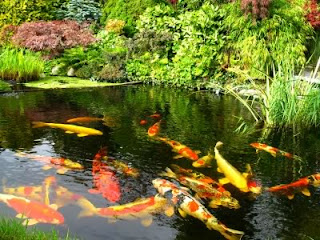
The Ultimate Koi Pond Water Quality Chart: Keep Your Fish Healthy and Happy
Introduction
Koi fish are a popular choice for those who keep garden ponds. These beautiful and graceful fish can provide hours of enjoyment and relaxation as you watch them swim around. However, keeping koi fish can also be challenging, especially when it comes to maintaining the water quality in your pond. This is why having a koi pond water quality chart is essential to ensure your fish stay healthy and happy.
Why is water quality important for koi fish?
Koi fish require specific water conditions to thrive. Poor water quality can lead to a host of health problems, including bacterial and fungal infections, parasites, and even death. Koi fish are also sensitive to ammonia, nitrite, and nitrate levels, which can build up in the water over time.
What is a koi pond water quality chart?
A koi pond water quality chart is a handy reference tool that helps you keep track of the water quality in your pond. The chart typically includes a list of the water parameters you need to test for, such as pH, ammonia, nitrite, and nitrate levels. It also includes the ideal range for each parameter, which makes it easy to see if you need to make any adjustments to your pond’s water quality.

How to use a koi pond water quality chart?
Using a koi pond water quality chart is easy. Begin by testing your pond water using a water testing kit. Once you have your test results, refer to the chart to see if your pond’s water quality falls within the ideal range for each parameter. If your test results fall outside the ideal range, you may need to make adjustments to your pond’s filtration system or add water treatments to help correct the issue.
What are the key water parameters to test for?
There are several key water parameters that you should test for in your koi pond. These include pH, ammonia, nitrite, and nitrate levels.
pH
pH is a measure of the acidity or alkalinity of the water in your koi pond. The ideal pH range for koi is between 7.0 and 8.0. If the pH falls outside this range, it can cause stress to your koi fish, making them more susceptible to disease and infections.

Ammonia
Ammonia is a toxic waste product that is produced by your koi fish as they excrete waste. High levels of ammonia in your pond can quickly become a health hazard to your koi fish, leading to red and swollen gills, lethargy, and even death. The ideal range for ammonia is 0 mg/L.

Nitrite
Nitrite is another waste product that is produced by your koi fish as they excrete waste. Nitrite is toxic and can cause a condition known as “nitrite poisoning” in your koi fish. Symptoms of nitrite poisoning include gasping for air at the surface of the water, lethargy, and loss of appetite. The ideal range for nitrite is 0 mg/L.

Nitrate
Nitrate is the final waste product that is produced by your koi fish as they excrete waste. Nitrate is less toxic than ammonia and nitrite, but high nitrate levels can still have a negative effect on your koi fish’s health. High nitrate levels can lead to poor water quality, which can make your koi fish more susceptible to disease and infections. The ideal range for nitrate is less than 40 mg/L.
How to maintain water quality in your koi pond?
Maintaining water quality in your koi pond requires regular testing and adjustments. Here are some tips to help you keep your pond’s water quality in check:
- Perform weekly water tests using a water testing kit.
- Add beneficial bacteria to your pond’s filtration system to help break down organic matter.
- Perform regular water changes to dilute waste and reduce nitrate levels.
- Avoid overfeeding your koi fish, as excess food can lead to high ammonia and nitrate levels.
- Install a quality filtration system to help remove waste and debris from the water.
Conclusion
A koi pond water quality chart is a must-have for any koi fish owner. By keeping track of your pond’s water parameters using a chart, you can ensure that your fish stay healthy and happy. Remember to perform regular water tests and adjustments to maintain water quality, and always seek the advice of a professional if you’re unsure about how to care for your koi fish.